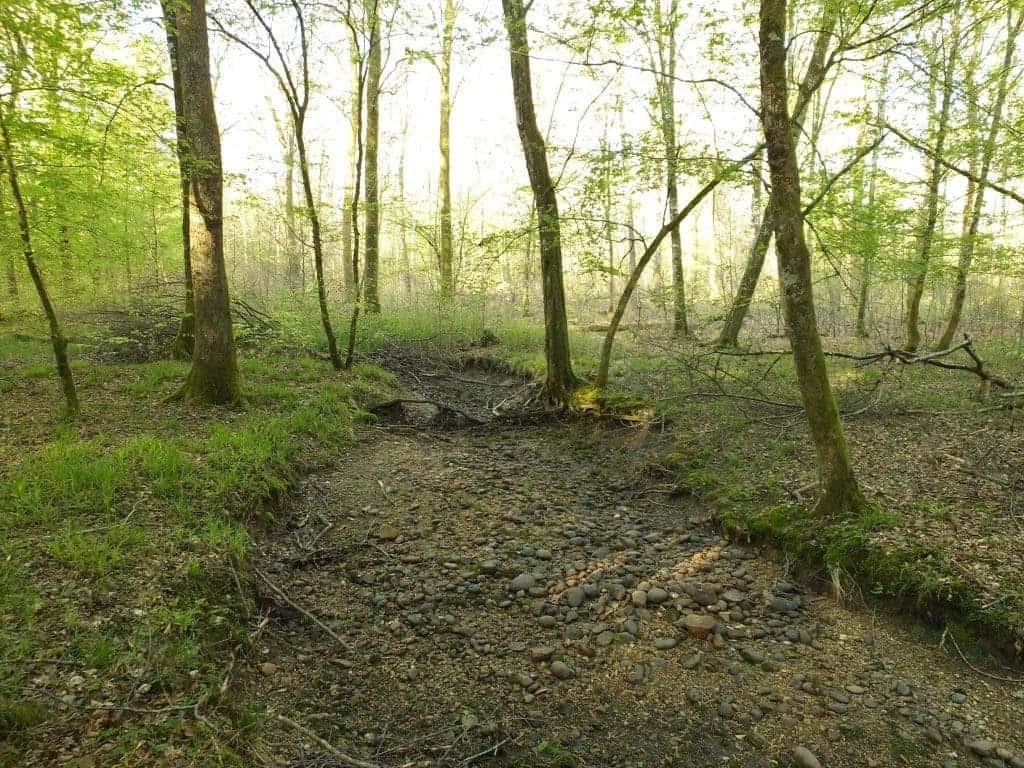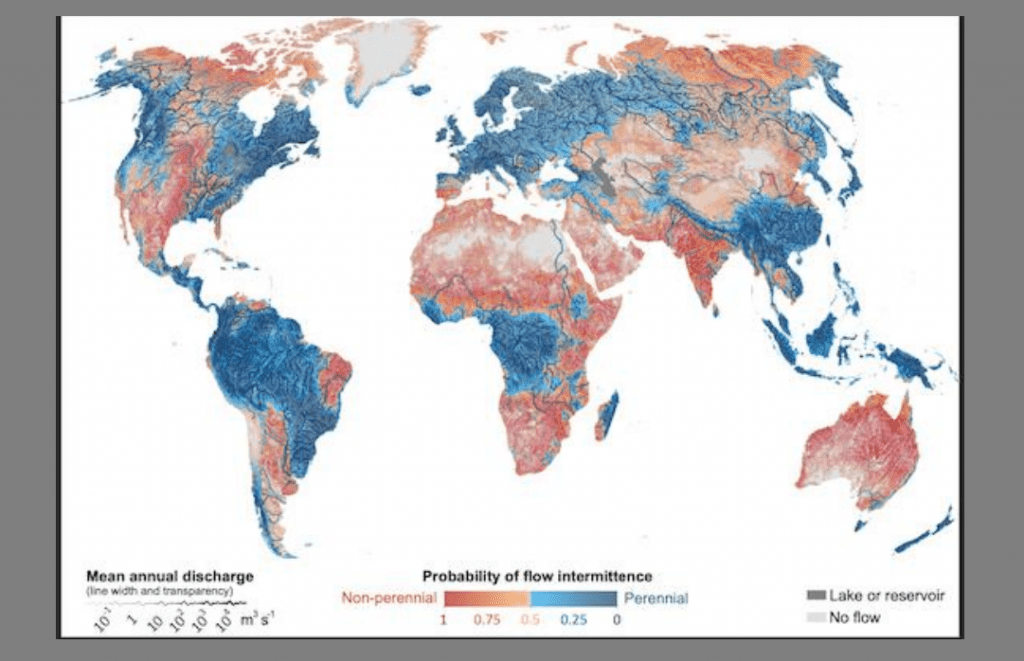
For the first time, scientists have quantified how much of the world’s 64 million-kilometer-long system of rivers and streams stops flowing periodically over the year. Turns out that between 51% and 60% of these global networks of flowing freshwater run dry for part of the year.
These findings show that river flow intermittency is far more common than previously thought, with important consequences for river-management practices and strategies, as well as scientists’ projections for how climate change may affect biodiversity and wildlife in the future.
“Over the past decade or so, a growing group of scientists has been repeating that non-perennial rivers and streams (those watercourses that periodically stop [flowing], sometimes also called intermittent or temporary rivers), are not only valuable ecosystems that need to be protected but also very widespread. We just did not have robust global numbers to back up this claim,” Mathis Messager, first author of the new study and Ph.D. student both in Geography at McGill and at the French National Research Institute for Agriculture, Food, and Environment (INRAE), told ZME Science.
Over half of the world’s rivers are non-perennial — yet they go unnoticed
Messager and distinguished colleagues, such as Dr. Thibault Datry, an ecologist specializing in non-perennial rivers and streams, and Dr. Bernhard Lehner, a global hydrologist, drew on their varied expertise to take on the novel task of empirically quantifying the global distribution of non-perennial rivers and streams. “I was the right fit for this task as I am doing a Ph.D. in both of these disciplines,” Messager told me in an email.
This was a highly challenging undertaking due to the fact that most non-perennial rivers and streams across the world are undermonitored. Actually, many are not even mapped. And, to add to the challenge, the researchers had to inspect thousands of long-term records of daily water flow in order to exclude sites that were affected by flow regulation (e.g. from a reservoir) and that shifted from perennial to non-perennial (and vice-versa) over time.
“The problem is that, whereas non-perennial rivers and streams comprise more than half of the global river network, less than a fifth of monitoring stations monitor their flow,” Messager said.
To top things off, then came the COVID pandemic mid-research, causing many interruptions and frustrations.
“It was a tremendous effort to push this study within 10 months, but I was committed to submit it before the end of the year. So in the end, I sent the study for review to Nature on December 24th at 7:30 pm while people in my house were waiting to start Christmas dinner,” Messager said.
Rivers that naturally stop flowing now and then are actually good for the environment
The researchers employed a predictive model that they developed to the RiverATLAS database, which accounts for nearly 23.3 million kilometers of the global river network. Their analysis showed that between 51% and 60% of rivers and streams by length cease to flow for at least one day a year, making non-perennial rivers the most widespread.
Most of these non-perennial rivers are found in arid places, the researchers observed, although rivers can dry up in tropical climates as well. Rivers in colder regions of the globe are also prone to flow cessation due to ice or storage of precipitation as snow rather than evaporation. Smaller rivers and streams are also much more likely to experience interruptions in their water flow.
Although this may sound like bad news, we don’t know yet if the number of rivers that were once perennial has decreased over time. What’s more, non-perennial rivers and streams are actually important ecosystems home to distinct species that have adapted to these cycles of water presence and absence. So the fact that such a sizable number of rivers and streams have an intermittent flow is no cause for concern, in and of itself.
“These watercourses are essential to the well-being of natural and human communities across the world. They provide food and water for millions of people and play an important role in the global water cycle and the cycling of chemicals like carbon. They are also an integral part of culture and language across societies. Examples of natural intermittent rivers include the Rio Grande, desert wadis in Egypt, high mountain streams in the Canadian Rockies, and many rivers along the Mediterranean region,” Messager said.
That being said, there seems to be a trend by which some once perennial rivers and streams are transitioning to non-perennial status. Over the coming decades, the researchers believe that an increasing proportion of the global river network will have some seasonal flow interruptions — and climate change may play a major role.
“We do know that many rivers that used to flow year-round, including sections of iconic rivers like the Nile, the Indus and the Colorado River have become intermittent in the past 50 years due to climate change, land use transitions, or withdrawals of water for human use and agriculture. Yet there has not yet been a comprehensive global study of the extent and drivers of shifts between perennial and non-perennial flow in rivers. My best guess would be that land use change and water withdrawals for irrigation and other human uses have been the main contributors to shifting rivers from being perennial to non-perennial, but that climate change is going to be the main contributor to future changes,” Messager said.

Year-round flowing rivers transitioning to non-perennial — that’s when it’s bad news
When a river that normally flows year-round experiences flow interruptions or even dries up, that’s when we should be worried. Perennial and non-perennial bodies of waters represent very distinct ecosystems and, as such, any sudden transition between the two states can threaten the various species and populations that have evolved there over thousands of years. Humans may also suffer if once important sources of water used for drinking, agriculture, fishing, or energy experience cessation in flow. Water quality may also suffer because pollutants increase in concentration once the volume of water goes down.
“On the other hand, it is also damaging to the ecosystem to let water flow year-round in a river that usually periodically dry. This happens when reservoirs are built to produce electricity and need continuous water flow for hydroelectric turbines, or due to effluents from wastewater treatment stations,” Messeger said.
More than half of the world’s population currently lives in areas close to rivers or streams that are non-perennial. Although most research and conservation efforts have focused on perennial water bodies, these latest findings show that non-perennial waters comprise the vast majority of the global river system and are thus worthy of more attention.
With this in mind, Messeger and colleagues plan to factor in land use change, river flow regulation by dams and reservoirs, water withdrawals by societies for irrigation and other uses, as well as climate change, to project the prevalence and distribution of non-perennial rivers in the future.
“We all live close to a river or stream that periodically stops to flow, regardless of the climate or continent. In fact, we made a rough estimate that for 52% of the world’s population, their nearest river or stream stops [flowing] at least one day per year on average. Even in wet tropical areas, if you follow the course of a stream counter to the direction of water flow (i.e. upstream), it’s likely that you will reach a section that’s dry for part or most of the year. Just like small blood vessels in the human circulatory system, these small streams play a crucial role in the cycling and quality of water that most of us depend on. That’s one of many reasons why these streams and rivers are important,” Messeger said.
“Despite this importance, however, non-perennial rivers and streams are often mismanaged or entirely excluded from conservation laws and environmental management actions. They are simply overlooked. There have also been several recent attempts to remove non-perennial rivers from environmental legislation and national water governance systems, including in the U.S. (Clean Water Rule) and France. This oversight usually leads to their rapid degradation through excessive water pumping, pollution, and overfishing, for example.”
“By promoting a recognition of the prevalence and importance of these ecosystems by the scientific community, decision makers, and the public, we hope to trigger efforts to adequately manage and protect them,” the researcher concluded.
The findings appeared in the journal Nature.






